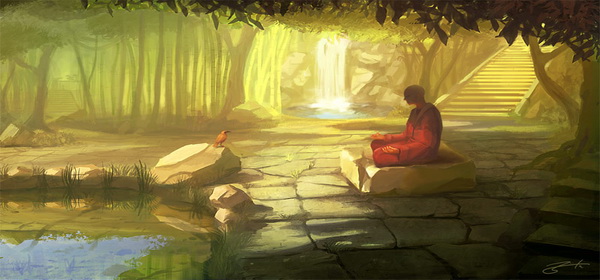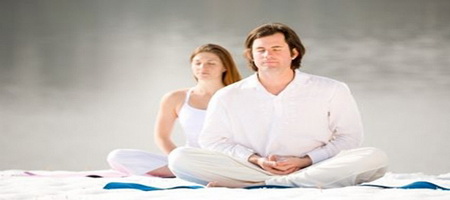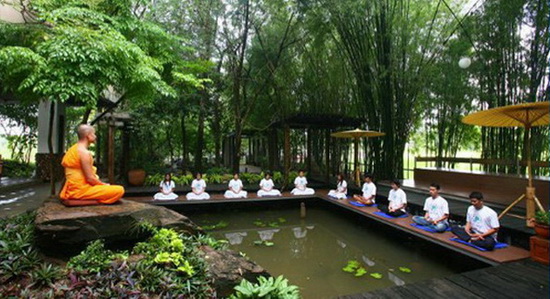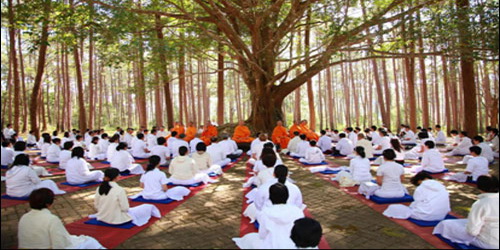Chiang Mai Meditation

Meditation is not just sitting with the eyes closed and relaxing. There is a major transformation happens to the brain and to the entire field of consciousness.
An ordinary person may consider meditation as a worship or prayer. But it is not so. Meditation means awareness. Whatever you do with awareness is meditation. “Watching your breath” is meditation; listening to the birds is meditation. As long as these activities are free from any other distraction to the mind, it is effective meditation.
Meditation is not a technique but a way of life. Meditation means ‘a cessation of the thought process’ . It describes a state of consciousness, when the mind is free of scattered thoughts and various patterns . The observer (one who is doing meditation) realizes that all the activity of the mind is reduced to one.

Reduced Stress
Meditation helps to reduce stress by teaching us to switch off from the worries that can plague us through the day. Meditation is an opportunity to spend time by ourselves, without feeling at the beck and call of others. Spending 15 minutes in quietening the mind and focusing on the present moment, makes us more relaxed and effective decision makers.
Health Benefits
Numerous studies have shown that meditation has health benefits. Many of these benefits are related to the decrease in stress that occurs through meditation. For example, with lower levels of stress and anxiety, the probability of heart disease diminishes significantly.
This is not to say meditation guarantees you good health. But, there is a growing awareness of the link between our state of mind and physical health. Quite often physical ailments are symptoms of inner turmoil. Meditation can give us peace of mind, and this can be a helpful step in avoiding many stress related ailments. Meditation has also been shown to relieve the pain associated with certain illnesses.
Control Your Own Thoughts
Man has conquered space, Mount Everest and numerous other challenges; but, are we able to conquer our own mind? How often do you find yourself victim to your own negative thoughts? Some people are even of the opinion that it is impossible to control your thoughts. However, the art of meditation teaches that, not only is it possible to control our thoughts, but, we can learn to stop them completely. Through meditation we can bring our unruly mind under control. This creates peace of mind and enables us to achieve what we want to.
Detachment
When we live in the mind it is easy to get distracted by small irritations. For example, maybe we find it intolerable to be kept waiting in a line, or we get upset by a small misdemeanour of another person. The solution is not to avoid these minor problems, because they will keep appearing no matter how hard we may try.
The only effective solution is to develop detachment and keep things in perspective. A powerful benefit of meditation is that we are able to detach ourselves from these insignificant, yet irritating thoughts. This detachment is not indifference, it is just that we are able to maintain equanimity in the midst of life’s inevitable turbulence.
Happiness and Peace of Mind
Is there anybody who does not, in some way, seek after happiness? Meditation takes us to the source of happiness, which is to be found in our own peace of mind. If we have no peace of mind and are constantly attacked by negative thoughts, happiness will remain elusive, no matter how successful we are on an outer plane. It is perhaps hard to imagine that happiness can occur from the simple act of being. However, if we can meditate with a still mind, we will discover an unexpected source of happiness within our own self. Meditation shows us that happiness is not dependent on outer circumstances, but on our inner attitude.
Concentration
Be it work, sport or music, concentration is essential to fulfill our potential. In one pointed concentration there is great power; our energy and focus do not get dissipated. When we have concentration we can do more in less time. Through meditation we gradually improve our powers of concentration; this focus can be used for both meditation, and also other activities we engage in.
Spontaneity and Creativity
When we live in the thinking mind, we are usually preoccupied with the past or future. When we spend our energy on the past and present we cover up our natural spontaneity and creativity. We may feel we have neither creativity or spontaneity, but, if we can learn to silence the mind, we realise that we have far more potential than we currently believe. To access this source of inspiration we just need to quieten the mind. Some of the great thinkers and scientists were able to make important discoveries when they could absorb themselves in their work, to the exclusion of all else. Meditation helps us to live in the current moment, and thus can help us to unlock our creative potential.
Discovering the Purpose of Life
If you are satisfied with your current life. If you feel perfect contentment and happiness then, at the moment, meditation is not necessary. However, if you feel empty inside; if you aspire to know more about the nature of existence and life, then meditation can be of great help. Usually we look for meaning in life through external events and other people. Meditation, however, shows us that we can gain a greater understanding of life through knowing who we are. In meditation we gain a new perspective of life, uncoloured by our own egoistic perspective. For those who wish it, meditation can become a lifelong process of answering the eternal question: “Who am I?”
The benefits of meditation are real, but, it also requires perseverance. It is mistake to expect all these benefits in the first few attempts; the mind takes time to tame. Also, it is difficult to explain all the benefits of meditation, because it involves a state of consciousness that cannot be expressed by words. To appreciate the benefits of meditation it is essential to meditate yourself. Alas, it is not sufficient to just read about it. Start meditating today!

There are thousands of meditation techniques from many different traditions, but all could be classified as belonging to either one or a combination of five types:
- Concentration Meditation
- Mindfulness Meditation
- Reflective Meditation
- Creative Meditation
- Heart-Centered Meditation
A person well versed in inner science traditions has access to a veritable apothecary of meditative antidotes to disturbing mind states, as well as to potent methods for enhancing and developing wholesome and helpful states of mind. Mastering our mind in these ways, we will inevitably develop mastery over our physical and verbal expressions and our relationship with the world.
1. Concentration Meditation Techniques
Concentration meditation techniques are the foundation for all other kinds of meditation. Through the power of concentration we build our capacity to overcome distraction and to sustain mental focus. The power of a scattered mind is very limited. But like a stream of water that can be channeled to make it more forceful and produce hydroelectric power, we can make the mind a more powerful instrument by developing a small seed of one-pointed mindfulness into “concentration power.”
In classical meditation texts, this one-pointedness of mind developed through the energy of concentration is called samadhi, which literally means “to establish, to make firm.”
The power of a concentrated mind can be focused effectively to enhance and deepen insight into other meditative themes or goals. To understand how this works, compare the illuminating capacity of the diffuse and scattered beam of a ten-watt incandescent lightbulb to the penetrating, diamond-like precision of a ten-watt laser beam. Such is the difference in illuminating power of the concentrated mind to the ordinary, scattered, and fragmentary flow of attention that most of us bring to everyday living.
By learning how to bring the stream of our attention into a laser-like beam of one-pointed concentration, we can train the mind to become a highly useful instrument for penetrating into and investigating the nature of reality. A concentrated mind is also the precursor of great bliss and the prerequisite for the development of psychic abilities.
Whatever technique of meditation you are practicing, it is necessary to have the ability to place your attention on the object of meditation and hold it there without distraction. With patience and practice, your mind will become calmer, more powerful, and able to apply itself to any task with precision and understanding. Any object or activity can be used for the specific development of concentration.
The same basic principle, however, always applies, no matter which form of meditation you are practicing: whenever your mind wanders, simply return it — again and again — to the object of your meditation.
2. Mindfulness Meditation Techniques
Mindfulness meditation techniques emphasize the cultivation of a receptive, choiceless quality of mindful attention toward whatever arises in the sphere of our experience. At those times in our lives when we were rapt in wonder gazing into the depths of the night sky, listening intently, marveling at the beauty of nature, or wholeheartedly listening for the answer to our heart’s prayer, we have naturally experienced this type of meditation.
Traditionally, the practices of insight or vipassana meditation, zazen, dzogchen, Mahamudra, choiceless awareness, self-remembering, and prayer of the heart are associated with this category of meditation. Mindfulness meditation strengthens our sense of wonder and appreciation, enabling us to effortlessly, precisely, and carefully attend to the totality of our experience unfolding moment to moment.
The interplay of concentration and mindfulness meditation allows us to develop the capacity to examine and intuitively understand the deep forces within our ordinary experience. The penetrating insight that develops can then be systematically applied to investigating the very subtle interฌplay between the phenomena we perceive and the nature of our own mind as the perceiver.
As we investigate our participation in the pervasive and dynamic interrelatedness of everything, we will come to sense ourselves as intimately related to and co-creative with the world of our experience.
3. Reflective Meditation Techniques
The practice of reflective or analytical meditation is like disciplined thinking: choosing a theme, question, or topic of contemplation we focus our reflection, or analysis, upon it. When our attention wanders to other thoughts, we return to our chosen topic.
Traditionally, reflective meditation is employed to gain insight into the meaning of life, death, interrelationships, and social conscience, or to come to a conclusive insight regarding some key idea in science, philosophy, or scripture. Following our analysis through, we arrive at a conclusion. This, in turn, gives rise to a strong sense of faith or conviction.
In our day-to-day life and work, reflective meditation techniques provide us with a powerful and effective tool for focusing our attention upon personal or professional questions in order to discover a creative solution or breakthrough insight. Reflective meditation also helps us to understand the issues or inner conflicts that may arise during the practice of other meditations.
4. Creative Meditation Techniques
Creative meditation techniques enable us to consciously cultivate and strengthen specific qualities of mind. Patience, appreciation, sympathetic joy, gratitude, love, compassion, fearlessness, humility, tenderness, and other qualities associated with aspects of nature, Divinity, or the natural world are among the attributes that are most commonly cultivated.
Creative meditations invite us to actively nurture these strengths of character by thinking, speaking, and acting “as though” these qualities are more fully alive within us.
5. Heart-Centered Meditation Techniques
Heart-centered meditation techniques help us to awaken the radiance of our loving-kindness and compassion. They deepen our empathy and forgiveness, and teach us to live in kinder ways.
They begin first with ourselves, and then open the circle of our compassion to embrace all living beings. They draw inspiration from each of the other meditations: focus and the power of peace from concentration; deep listening and presence from mindfulness meditation; insight into the nature of suffering and a sense of interrelatedness from reflective meditation; imaginative resourcefulness and skill from creative meditation.
Properly understood, all of these types of meditation are interrelated and mutually enhancing. Many practices draw inspiration from a variety of meditation types and could be included in several categories.
While the intricacies of these interrelationships are beyond the scope of this site, it should be clear to you that the contemplative traditions offer us the inner technology necessary to fulfill virtually any developmental aspiration we may have.
Meditation allows us to go beyond words and mental concepts in order to know the true nature and reality of ourselves and our world directly

INTRODUCTION
The Buddha invited all to come and investigate his teachings. For the Buddha not only found a way to the end of suffering, but he actually taught a way which we can choose to follow. He observed how all human beings sought happiness and How nearly all failed to find lasting contentment. So, out of Compassion, the Buddha taught the Four Noble Truths-of The way things are how we can develop the mind toward Nibbana, The highest happiness, the most perfect peace.To do this, we need to obtain instructions through Teachers and books, then apply the teaching to our lives. The Buddha presen teddifferent methods of practice to suit the varied personalities of his students. All methods, however, involve a foundation of virtuous conduct, application of mindfulness, development of concentration to focus the mind, and growth of wisdom through investigation and reflection. The key point to remember is the Buddha could only point the way; we must do the practice in order to progress toward realization of Nibbana.
ADVANTAGES OF PRACTICE IN THAILAND
To visit Thailand is to experience Thai Buddhism – for the culture and religion cannot be separated. Thais have followed and supported the Buddha’s teachings for more than a thousand years. Much of Thai life centers around the local wat (temple or monastery) where people come for worship, sermons, advice on family matters, meditation, schooling for children, and traditional medicine. Many boys and men take on robes as novices or monks for short periods in order to fully immerse themselves in the Buddha’s way of life. Men who choose to spend all their lives in robes receive great respect. Thais also welcome foreigners to come and practice the Buddha’s teachings. The extremely supportive environment of a good Thai wat or meditation centre provides inspiration and opportunity for spiritual development that’s rare in the world today.
Thais believe the Buddha’s teachings to be priceless; no money is asked or expected in return for meditation instruction. In nearly all cases, such things as accommodations and food are free too. Generosity of the laypeople enables the wats and meditation centres to function in this remarkable manner. Some meditation centres do charge a fee for room and board, but this is miniscule compared to charges at retreats in western countries. For stays of a few months or more, one can have the benefit of practice in Thailand for less cost than a retreat in one’s home country, even after paying airfare. But of the thousands of wats and meditation centres in Thailand, which one to choose? This book was written to help you get started and to assist in an enjoyable stay. The wats and centres described in these pages represent some of Thailand’s best meditation traditions.
All welcome foreigners; usually some English is spoken or a translator can be found. Many more excellent teachers and places to practice exist too. You’ll hear about some of these during your stay.
CHOOSING A WAT OR MEDITATION CENTRE
Because different Thai wats and meditation centres offer so many practices and environments, one may wish to carefully consider which place will be most suitable. At most wats, monks devote the majority of their time to ceremonies and to study of Buddhist scriptures. Noise, many people coming and going, and lack of a suitable teacher can make meditation practice difficult at these places. A small percentage of wats, however, do offer very supportive conditions for meditation.
These wats typically have a peaceful environment, teachers who can help with difficulties, and freedom for one to choose the meditation technique that works best. Some of Thailand’s forest wats follow a “Way of Life” in which the monastic discipline and daily routine receive equal emphasis with formal meditation techniques. Meditation centres specialize in practice either a particular meditation system or one of the meditator’s choosing, depending on the centre. These centres have minimal or no chanting and ceremony so that maximum time can be devoted to formal practice.
If you’re new to Buddhist meditation, consider the 10-day retreats offered at Suan Mokkh and Wat Kow Tham in southern Thailand; western teachers conduct the retreats, so you don’t have to worry about language or cultural misunderstandings. Frequent talks and interviews allow one to get a good basic understanding of practice and to clear up any doubts about the meditation techniques.
Because Thais traditionally do temporary ordinations during the 3 month Rains Retreat, from mid- or late July to October, expect more crowded conditions at some places then. This can be an especially good time to stay, however, as many wats place extra emphasis on practice. Monks take up residence in their chosen monastery, so there’s much less coming and going. Meditators would be wise to check in by early June to make arrangements to stay for the Rains Retreat.
Teachers
Whether one is new to meditation or has done many years of practice, a teacher or “good friend” can be of great help. The teacher also sets an example for the wat or centre and determines the discipline. Monks traditionally devote 5 years to their first teacher.
Daily Schedules
Some wats and centres expect laypeople to participate in group activities. Other places let them make and follow their own schedule. A few meditation centres offer only intensive individual practice — sitting, walking, meals, and other activities take place in or near one’s room in solitude. Residents of most wats begin the day early, typically 3-4 a.m. in forest monasteries and 5 a.m. in towns, with meditation and chanting. Meditation centres expect early rising too, with sleep limited to 4 to 6 hours. Monks and novices go on pindabat (alms round) at daybreak, then eat once or twice in the morning, depending on the custom of the wat or centre. You may also see maechees (8-precept nuns) on pindabat in central and northern Thailand and pakows (anagarikas, 8-precept laymen) in the northeast. Most wats have another period of meditation and chanting in late afternoon or evening. The rest of the day is used for meditation, work projects, and personal needs. At some intensive meditation centres you will be encouraged to practice 20 hours a day.
A typical daily routine has been listed for many places; expect changes at many wats, however, on wan phra, the Buddhist holy day that falls on the full, new, and half moon (every 7 or 8 days). Many laypeople come to make special offerings, hear sermons, chant the refuges and precepts, and practice meditation. Some visitors may stay at the wat all day and night, sleeping as little as possible. Additionally, monks gather on the full and new moon for a recitation of the Patimokkha, the 227 rules of discipline for the order.

- Wat Umong
- Wat Ram Poeng
- Tham Thong Meditation Centre
- Chom Tong Insight Meditation Center
- Wat Thaton
- Wat Phrathat Doi Suthep
Message from us : For these meditation programs are not a commercial business ( No any commission ). About meditation expenses at temple be like a donation. We would like only to give information for our customers about the place for making Buddhist meditation in Chiangmai. So, you could contact by yourself. But it’s not comfortable, we could help you for free service to contact with any places where you prefer and we have transfer service to that place which is not too expensive.












We are looking for a one day introductory meditation course in Chiang Mai. Are there any, and if so which do you recommend?
I WILL BE TRAVELLING TO THAILAND AND WILL BE IN CHAING MAI ON APRIL 23 AND APRIL 24TH. I HAVE SOME EXPERIENCE WITH MEDITATION AND WOULD BE INTERESTED IN A ONE DAY BUDDHIST MEDITATION CLASS/COURSE. WHAT WOULD YOU RECCOMEND AND AT WHICH ONE OF THE TEMPLES IN CHAING MAI
I am looking for an Buddism emersion experience. Approximately 4 weeks over the summer. Can you make any recommendations?
Hi I would like to learn Buddhism through meditation and mindfulness. I would like a 10 day retreat. What months do these run and what is the cost for 2019. I would love to hear from you regarding the above. Warm regards Patti from New Zealand.
I do meditate. What one day meditation experience in the northern region of Thailand would you suggest while my friends take a biking tour.